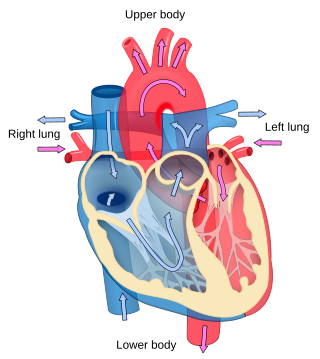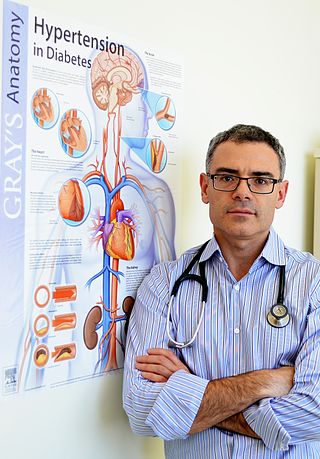Related Research Articles

Cardiology is the study of the heart. Cardiology is a branch of medicine that deals with disorders of the heart and the cardiovascular system. The field includes medical diagnosis and treatment of congenital heart defects, coronary artery disease, heart failure, valvular heart disease, and electrophysiology. Physicians who specialize in this field of medicine are called cardiologists, a specialty of internal medicine. Pediatric cardiologists are pediatricians who specialize in cardiology. Physicians who specialize in cardiac surgery are called cardiothoracic surgeons or cardiac surgeons, a specialty of general surgery.

Atrial flutter (AFL) is a common abnormal heart rhythm that starts in the atrial chambers of the heart. When it first occurs, it is usually associated with a fast heart rate and is classified as a type of supraventricular tachycardia. Atrial flutter is characterized by a sudden-onset (usually) regular abnormal heart rhythm on an electrocardiogram (ECG) in which the heart rate is fast. Symptoms may include a feeling of the heart beating too fast, too hard, or skipping beats, chest discomfort, difficulty breathing, a feeling as if one's stomach has dropped, a feeling of being light-headed, or loss of consciousness.

Short QT syndrome (SQT) is a very rare genetic disease of the electrical system of the heart, and is associated with an increased risk of abnormal heart rhythms and sudden cardiac death. The syndrome gets its name from a characteristic feature seen on an electrocardiogram (ECG) – a shortening of the QT interval. It is caused by mutations in genes encoding ion channels that shorten the cardiac action potential, and appears to be inherited in an autosomal dominant pattern. The condition is diagnosed using a 12-lead ECG. Short QT syndrome can be treated using an implantable cardioverter-defibrillator or medications including quinidine. Short QT syndrome was first described in 2000, and the first genetic mutation associated with the condition was identified in 2004.
Ventricular tachycardia is a fast heart rate arising from the lower chambers of the heart. Although a few seconds of VT may not result in permanent problems, longer periods are dangerous; and multiple episodes over a short period of time are referred to as an electrical storm. Short periods may occur without symptoms, or present with lightheadedness, palpitations, or chest pain. Ventricular tachycardia may result in ventricular fibrillation (VF) and turn into cardiac arrest. This conversion of the VT into VF is called the degeneration of the VT. It is found initially in about 7% of people in cardiac arrest.

Cardiac electrophysiology is a branch of cardiology and basic science focusing on the electrical activities of the heart. The term is usually used in clinical context, to describe studies of such phenomena by invasive (intracardiac) catheter recording of spontaneous activity as well as of cardiac responses to programmed electrical stimulation - clinical cardiac electrophysiology. However, cardiac electrophysiology also encompasses basic research and translational research components. Specialists studying cardiac electrophysiology, either clinically or solely through research, are known as cardiac electrophysiologists.

Catheter ablation is a procedure that uses radio-frequency energy or other sources to terminate or modify a faulty electrical pathway from sections of the heart of those who are prone to developing cardiac arrhythmias such as atrial fibrillation, atrial flutter and Wolff-Parkinson-White syndrome. If not controlled, such arrhythmias increase the risk of ventricular fibrillation and sudden cardiac arrest. The ablation procedure can be classified by energy source: radiofrequency ablation and cryoablation.
Tachycardia-induced cardiomyopathy (TIC) is a disease where prolonged tachycardia or arrhythmia causes an impairment of the myocardium, which can result in heart failure. People with TIC may have symptoms associated with heart failure and/or symptoms related to the tachycardia or arrhythmia. Though atrial fibrillation is the most common cause of TIC, several tachycardias and arrhythmias have been associated with the disease.
Clinical cardiac electrophysiology, is a branch of the medical specialty of cardiology and is concerned with the study and treatment of rhythm disorders of the heart. Cardiologists with expertise in this area are usually referred to as electrophysiologists. Electrophysiologists are trained in the mechanism, function, and performance of the electrical activities of the heart. Electrophysiologists work closely with other cardiologists and cardiac surgeons to assist or guide therapy for heart rhythm disturbances (arrhythmias). They are trained to perform interventional and surgical procedures to treat cardiac arrhythmia.
The following outline is provided as an overview of and topical guide to cardiology, the branch of medicine dealing with disorders of the human heart. The field includes medical diagnosis and treatment of congenital heart defects, coronary artery disease, heart failure, valvular heart disease and electrophysiology. Physicians who specialize in cardiology are called cardiologists.

Michel Haïssaguerre is a French cardiologist and electrophysiologist. His investigations have been the basis for development of new markers and therapies for atrial and ventricular fibrillation.
The Sensei X robotic catheter is a medical robot designed to enhance a physician’s ability to perform complex operations using a small flexible tube called a catheter. As open surgical procedures that require large incisions have given way to minimally invasive surgeries in which the surgeon gains access to the target organs through small incisions using specialized surgical tools. One important tool used in many of these procedures is a catheter used to deliver many of things a surgeon needs to do his work, to impact target tissue and deliver a variety of medicines or disinfecting agents to treat disease or infection.

Atrial fibrillation is an abnormal heart rhythm (arrhythmia) characterized by rapid and irregular beating of the atrial chambers of the heart. It often begins as short periods of abnormal beating, which become longer or continuous over time. It may also start as other forms of arrhythmia such as atrial flutter that then transform into AF.

Henrick Joan Joost Wellens, M.D., (1935–2020) was a Dutch cardiologist who is considered one of the founding fathers of clinical cardiac electrophysiology - a discipline which enables patients with cardiac arrhythmias to have catheter electrode mapping and ablation.

Arrhythmias, also known as cardiac arrhythmias, heart arrhythmias, or dysrhythmias, are irregularities in the heartbeat, including when it is too fast or too slow. A resting heart rate that is too fast – above 100 beats per minute in adults – is called tachycardia, and a resting heart rate that is too slow – below 60 beats per minute – is called bradycardia. Some types of arrhythmias have no symptoms. Symptoms, when present, may include palpitations or feeling a pause between heartbeats. In more serious cases, there may be lightheadedness, passing out, shortness of breath or chest pain. While most cases of arrhythmia are not serious, some predispose a person to complications such as stroke or heart failure. Others may result in sudden death.
Andrea Natale is an Italian-born American cardiologist and electrophysiologist, i.e. a heart rhythm specialist. Natale is known for his work in atrial fibrillation ablation, and he is currently the executive director at the Texas Cardiac Arrhythmia Institute.

Yaariv Khaykin is a Canadian cardiologist and a clinical researcher in the area of electrophysiology. He is the director of the Newmarket Electrophysiology Research Group at the Southlake Regional Health Centre. He has published research into complex ablation and pioneered cardiac ablation methods.
Robotic magnetic navigation (RMN) uses robotic technology to direct magnetic fields which control the movement of magnetic-tipped endovascular catheters into and through the chambers of the heart during cardiac catheterization procedures.
Iqbal Mahmoud Al Assad is a physician pursuing a pediatric cardiology fellowship at Boston Children's Hospital. She was recognized as one of the youngest doctors in the world when she completed her medical training at age 20. Her name is also seen as Iqbal El-Assaad in some sources.
Sanjiv M. Narayan is a British-born American physician, biomedical engineer, and academic researcher. He is a Professor of Medicine at Stanford University. Narayan's work is focused on treating patients with heart rhythm disorders, particularly those with atrial fibrillation. His research applies bioengineering and computational methods to develop improved diagnostic tools and therapy.

Günter Breithardt is a German physician, cardiologist and emeritus university professor. He is known for his research in the field of rhythmology, especially the diagnosis and pharmacological and non-pharmacological therapy of cardiac arrhythmias and acute cardiac death, in particular the identification of arrhythmia-triggering gene mutations. For 21 years he headed the Medical Clinic and Polyclinic C at Münster University Hospital. A number of his academic students hold university management and chief physician positions.
References
- 1 2 "Dr. Bruce B. Lerman, MD, New York, NY," U.S. News & World Report.
- 1 2 3 4 5 6 7 8 9 "Bruce B. Lerman, M.D.," Weill Cornell Medicine.
- 1 2 "Lerman, Bruce B," Weill Cornell Medical College.
- ↑ Jonathan LaMantia (May 6, 2019). "State report names top hospitals for heart care," Crains New York.
- ↑ Nicole Lyn Pesce (September 13, 2018). "This new Apple Watch feature could be ‘game-changing’ for women’s health," MarketWatch.
- ↑ "Imaging Technique for Treating Heart Condition Should be More Widely Adopted to Minimize Radiation Exposure; Researchers from NewYork-Presbyterian and Weill Cornell Medicine Advocate for Atrial Fibrillation Procedure that Reduces Radiation Exposure," Weill Cornell Medicine, June 1, 2017.
- ↑ "Adoption of fluoroless catheter ablation may rise with proper training", CardiologyToday, June 23, 2017.
- ↑ "Bruce Lerman | Weill Cornell Medical College, NY | Cornell (Division of Cardiology)," ResearchGate.
- ↑ "Lerman, Bruce B," Weill Cornell Medical College.
- ↑ Dr. Craig T. Basson, MD, PhD, Dr. Bruce B. Lerman, MD (2009) Topics in Arrhythmias and Ischemic Heart Disease, Demos Medical Publishing, ISBN 1935281747.